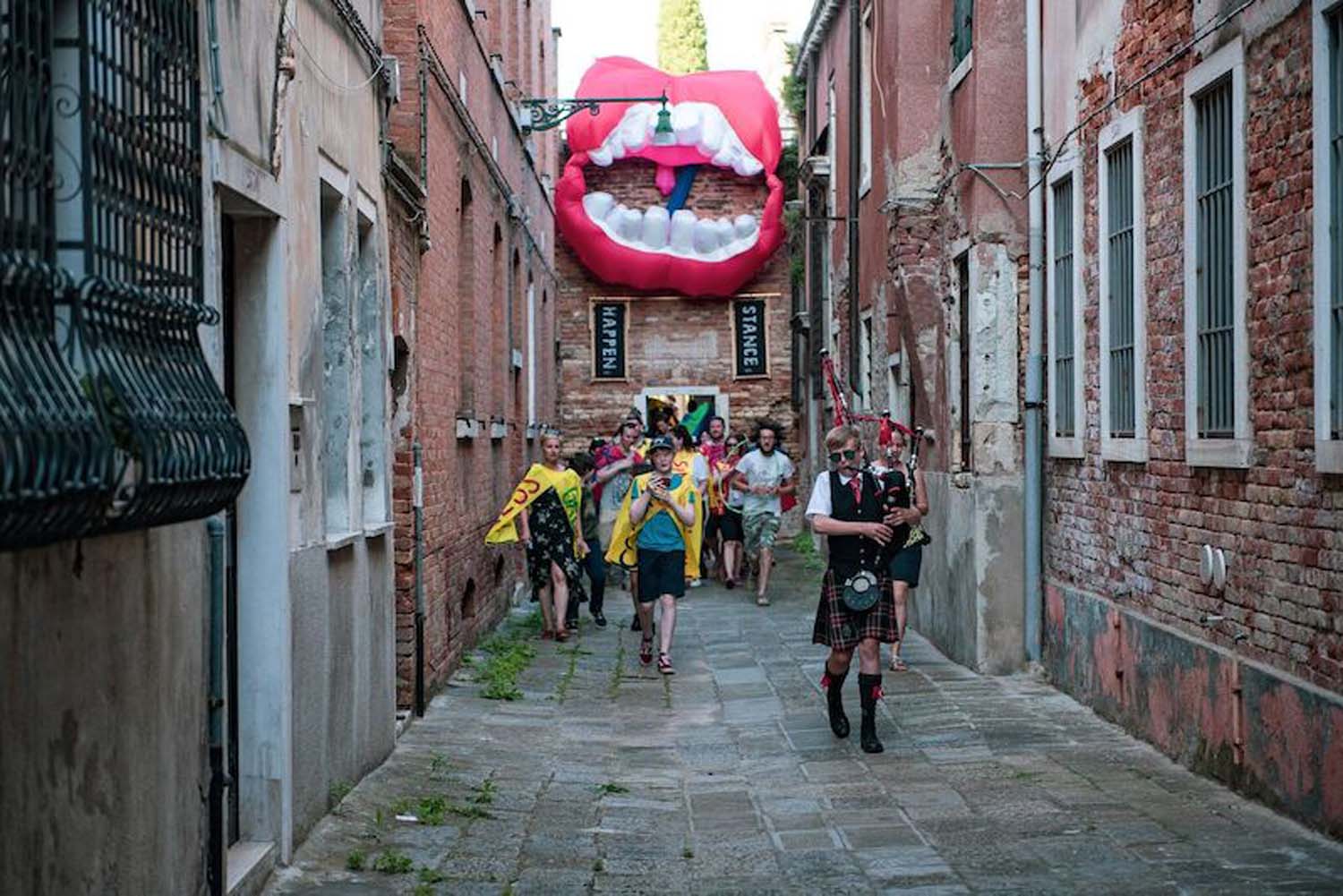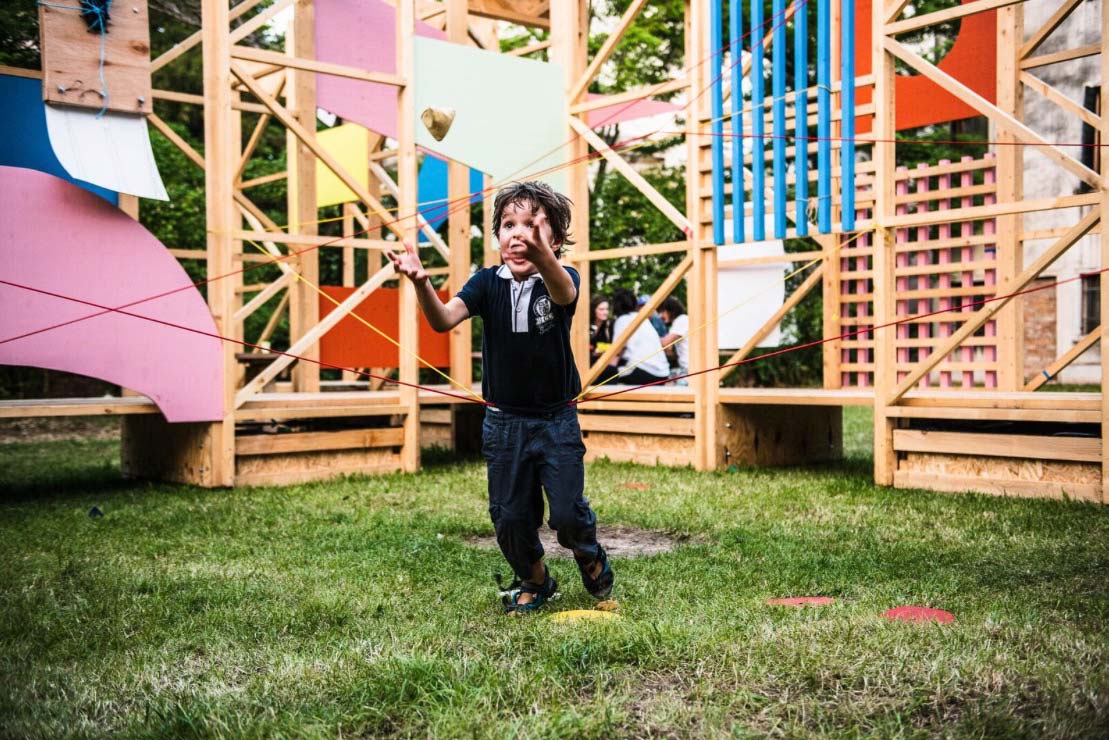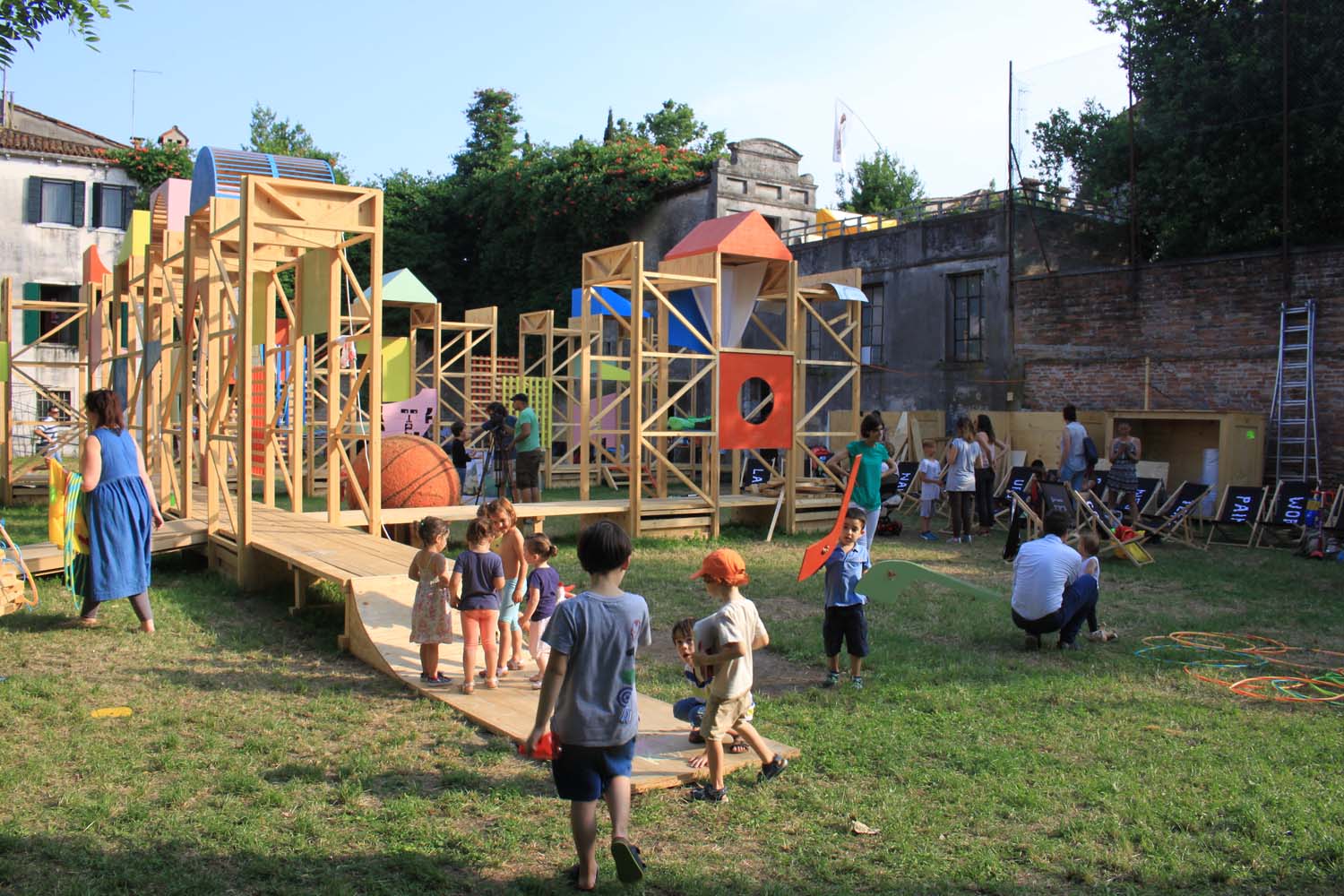Venetians adopt Happenstance as their own free space

Journalist Susan Mansfield visited The Happenstance in summer 2018. The critically acclaimed project was Scotland’s contribution to the Biennale Architettura 2018 in Venice. Her report explores how Venetians have adopted it as their own ‘free space’.
At 4pm, everything changes at The Happenstance. All day, the team at Scotland’s project for this year’s Venice Architecture Biennale host a steady flow of Biennale visitors and tourists. But at 4pm, when the school bell rings, the open-air space becomes a playground.
The kids flood into the garden under Gobby, the giant inflatable mouth made by artists Pester & Rossi, and along the wooden armature designed by Baxendale Studio (Lee Ivett and Ambrose Gillick). They swing on it, make dens under it, use it as a skateboard track, and participate in the games designed back in Scotland by artists, architects and young people.
In The Happenstance, lead artist Peter McCaughey, of Glasgow-based art organisation WAVEparticle, set out to create a genuinely ‘free space’ – the theme of this year’s Biennale, set by Yvonne Farrell and Shelley McNamara of Dublin-based Grafton Architects, the curators of the main exhibition areas in the Arsenale and Giardini. At 4pm, in the garden, in the Venetian sunshine, it is clear how successful the team has been.
“The idea of architecture-plus, that architecture is not just about designing buildings but also systems and connecting people: it has been eye-opening to view architecture in that way. It’s about people, really.”
A living, breathing, functioning system
When the children head home, another crowd streams in, mostly young adults – both locals and visitors – coming in to sit in the bespoke deckchairs (66 of them, all printed with a different word), shoot the breeze, listen to musicians play or watch a film on the screening wall of the open-air cinema.
“I’ve never been at the heart of a project like this,” says McCaughey, who has run successful ‘free spaces’ in Glasgow at the Laurieston Arches and the Caledonia Road Church. “It’s not an abstract artwork, it’s not an architectural model, it’s not even a demonstration of an idea, it is real life. The thing is a living, breathing, functioning system.”
Architecture journalists at the Biennale have praised the space. Oliver Wainwright, in The Guardian, wrote that “it demonstrates the power of architecture, however rough and ready, to bring people together in an open, messy, joy-filled space”.
With a set list of more than 100 participating architects and 65 national pavilions in the Biennale, The Happenstance was listed in New York’s Metropolis Magazine’s Top 10, included in The Architects Journal’s ‘Magnificent Seven’ and, selecting it for its Top Five picks of the Biennale, Architectural Review called it “an essay in reclaiming and reactivating space in the city”.

Working with young people
The Happenstance began back in Scotland with a series of projects by artists and architects working with young people (the same practitioners have also run activities and workshops in Venice).
The Scotland + Venice partnership, which includes the Scottish Government, Creative Scotland and Architecture and Design Scotland, wanted the project to celebrate Scotland’s Year of Young People as well as reflect the ‘free space’ theme. A touring element of the project will return to Scotland in August this year.
As soon as McCaughey saw the garden, in the grounds of Palazzo Zenobio, the home of the Armenian College Moorat-Raphael, he knew he had found the perfect location. Off the beaten track, and away from the main Biennale zones in a residential part of the city, it was the ideal place to host an exploration of free space which involved local Venetians as much as the Biennale crowd.
A free space
Working on the same principle McCaughey had used in Glasgow, he made the garden available to any person or organisation who wanted to use it. Since opening on the 23 May, The Happenstance has played host to a series of diverse events and activities including:
-
outdoor screenings of local Venetian and Scottish films
-
a music festival
-
an international day of yoga complete with sitar player
-
African Gospel singers
-
Italian rural dancers
-
a Mexican culture evening of food, films and dancing
Bonds have been forged with the community, from local politicians to the men who hang out at the nearby bocce ball court. The opening event incorporated elements of the Sagra, a local festival, taking place in nearby Campo Raffaele. Locals have said they hope to keep elements of the project open after the Biennale finishes. To date, The Happenstance has seen a footfall of more than 12,000 visitors, the majority of whom have been Venetian.
McCaughey says: “To be local is second nature to me. So it was natural to pay attention to the site and the people who live here and work near here. But I’m amazed at the level we are embedded here, after just a few weeks. I am staggered at how much has been achieved in the short time that we’ve been here.”
Alberto Lago, who is an artist and designer based in Venice, joined The Happenstance team to help them make local connections, emphasises how unusual this is. “It’s super rare. There is a scepticism about the Biennale, even though it is a significant part of the city’s income. But the people who come to The Happenstance are mostly Venetians. People come here with a smile, and go out with a bigger smile, because it is a real free space, a free space for everybody.”
The issue of free space is a live one in Venice, a city which receives 30 million visitors a year but has fewer than 55,000 residents. Rising rents on commercial properties are pushing out traditional craftsmen in favour of pizza and ice-cream shops, and many locals are worried that the policies of the current right-wing mayor of the Veneto will turn the city into a theme park.
Architecture plus
For architects Lee Ivett and Ambrose Gillick, designing the armature for The Happenstance was about reflecting elements of the local environment: the wooden walkway echoes the shape of the city’s narrow streets and wooden roof terraces. The structure was built with local materials, and local people joined the Scottish team to help with the build. Lee Ivett was adamant that the armature would not be an exhibition to be admired, but a structure to be inhabited. This is what everyone on the team calls “architecture plus”: design which reflects, and comes to life through, the people who use it.
He says: “I think the success of the space is in the real, diverse range of activity it’s managing to support, whether that’s screening films, putting on a music festival, kids coming and building dens, or tourists hanging out here and having their lunch. I think that’s something that’s missing from a lot of public space in Scotland and the UK. Most public space now, and a lot of architecture, dictates behaviour. The idea here was to create a device or a piece of infrastructure that doesn’t dictate behaviour, it suggests potential behaviour and opens up possibilities.”
Playful and curious persona
Although the children were the first to pick this up, the aim for the project was always deeper. Embedded in The Happenstance is the idea of encounter, conversation, epiphany. Peter McCaughey says: “It’s not about children, it’s about the child in all of us, and how that type of playful and curious persona is encouraged in all of us. We try to create an encounter with everyone who comes into the garden.”
And everyone on the team has their stories of encounters: the German-Armenian art historian who came with her granddaughter before the build was even finished; the theoretical physicist who was one of the pioneers of quark theory at Cern; the Frenchman who has dedicated his life to providing paragliding trips for children who cannot walk; the travelling glass artist from Montreal who has joined the team as an extra helper; the young Venetian filmmaker, studying in Berlin, whose short film about the Lagoon’s abandoned islands was screened in the garden to widespread acclaim.
At the forefront of these encounters are the five “fellows” – students selected from Scotland’s five schools of architecture who help run The Happenstance day-to-day. Theo Shack, who has just finished fourth year MA Architecture at the University of Edinburgh, says he has been trying to describe the job to his friends at home: “Litter-picker-cum-clown, child-minder-cum-builder, designer, cook. Every single day is unexpected, that’s the most predictable thing about it.”
“It’s been the most amazing experience. The idea of architecture-plus, that architecture is not just about designing buildings but also systems and connecting people – that’s been very eye-opening, to view architecture in that way. It’s about people, really.”
“People come here with a smile, and go out with a bigger smile, because it is a real free space, a free space for everybody.”
Footnote: after Venice
After the opening weekend, it was clear to everyone, core team, fellows, the promoters, residents and staff of Palazzo Zenobio, that what they had created was a successful, engaging resource, immediately adopted by locals, visitors and Biennale tourists. WAVEparticle began to explore how this resource could extend beyond its finite timescale of 25 June. It was announced at the start of July that several cornerstones are now in place to help make this a reality:
- The armature has been sold to the Armenian College at Palazzo Zenobio (who have loved the level of activity on what was previously an abandoned, unused football field)
- The Venice Municipality are programming Nuovo Cinema Libero (free outdoor cinema screenings throughout the summer months)
- Workshops and meetings are continuing in the space supported by a skeleton WAVEparticle staff, headed up by Alberto Lago along with local volunteers.
Such is the level of interest, WAVEparticle are receiving requests to use the space on a daily basis from local community organisations, groups and individuals. One week alone has seen a marionette-making workshop for the Open Stage Festival, the annual general meeting of Poveglia per tutti, a local organisation attempting a community buyout of the adjacent island of Poveglia, and the screening of ‘Anffas Venezia’ – video testimonials of life in the city, for and with people with disabilities. There is a genuine sense that there is mutual interest across the board in seeing a programme of work continue.

Read more of Susan Mansfield’s writing on The Happenstance
Susan Mansfield is a journalist, writer and art critic for The Scotsman. She also spoke to lead artist Peter McCaughey in an interview about freeing people to think about free space. And in a series of short blogs, Peter wrote about his reflections on The Happenstance.
Image credit: Graham Ross
Header image credit: Brian Hartley
Scotland + Venice
The Happenstance was Scotland’s 2018 contribution to the International Architecture Exhibition. Learn about Scotland’s participation over the years.
